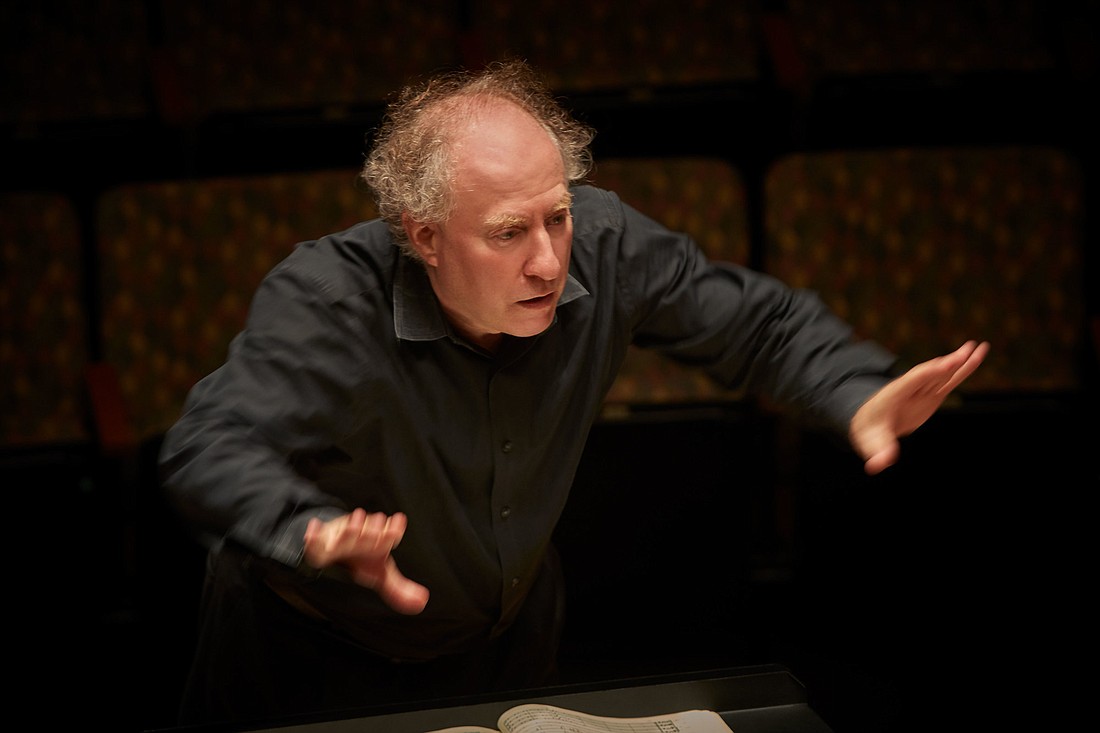- January 15, 2025
-
-
Loading

Loading

Just when we thought the Sarasota Music Festival couldn’t get any better, it did, with two more outstanding concerts at the Sarasota Opera House — each ending with an extra special treat.
Friday night’s concert, “Appalachian Spring,” began with two contrasting compositions that had their beginnings in the world of dance. Darius Milhaud’s ballet “The Creation of the World” actually precedes Gershwin’s “Rhapsody in Blue” by more than a year, yet the two share harmonies, “blue” notes and jazz licks as if they were fraternal twins.
Milhaud’s piece, written after a brief American sojourn, is scored for a Harlem jazz orchestra of trumpets, trombones, woodwinds and percussion, but adds two violins, cello and bass, with an alto saxophone playing what would be the viola voice. Jeffrey Kahane led the group of faculty, student and guest artists in a spirited, but controlled romp through the score, led by Don Rhynard’s smooth-sounding alto saxophone.
I’m sure few in the audience knew that Copland’s “Appalachian Spring” was originally written for only 13 instruments — all the small space in the Library of Congress could accommodate. Copland later scored his ballet for full orchestra, the version most everyone knows. Kahane, conducting from the piano, chose the original version with flute, clarinet, bassoon, piano and strings — a real piece of chamber music, again combining faculty and young performers. Rather than sounding lean or empty, we were presented with an uplifting performance of this work that allowed every musical voice to shine with sparkling clarity.
In a brief contrasting mood, Jonathan Spivey, principal pianist for the Sarasota Orchestra, offered “Three Norwegian Peasant Dances,” transcribed and expanded from early folk material by composer Edvard Grieg. Grieg raised the profile of these dances by expanding their harmonies and musical structures, all well phrased and played by Spivey, who spent his early years in neighboring Sweden.
Saturday evening’s concert, “Influence and Individuality,” began with Sergei Prokofiev’s “Overture on Hebrew Themes” written in New York for a chamber group of fellow ex-patriots from the Russian Revolution. Based on old Hasidic dances with a definite Klezmer feeling, the rather odd combination of string quartet, piano and clarinet provided just the right atmosphere to this composition, which was in turn solemn, sprightly and mournful — and expertly performed.
Pianist Vijay Venkatesh was a student in last year’s festival, but returned as a solo artist to perform Saint-Saëns Piano Concerto No. 2. Venkatesh was at all times in complete control of this concerto, from the improvisatory introduction to the rather stately first movement, the brisk scherzo of the second to the finger-bending virtuosity of the final tarantella. He gave a masterful performance, showing great dexterity and musical taste throughout.
All of this brought us to the grand finales of these concerts — decidedly different, but each an inspiring and uplifting musical experience.
Friday’s concert concluded with Dvorak’s String Quintet in E flat Major, the “American Quintet” written during the composer’s stay in Spillville, Iowa. It was performed by students Katherine Arndt, violin ,Damon Taheri and Halam Kim, viola, faculty Zachary DePue, violin, and guest artist Natalie Helm, cello, all giving us an energetic, insightful and most musical performance. At times Dvorak’s musical structure can be episodic and difficult to stitch together, but these fine players did that to perfection, presenting a completely unified interpretation. The final Rondo was an absolute delight.
Tchaikovsky's “Serenade for Strings” is most often performed by orchestral strings with a conductor presiding from the podium, but on Saturday evening the performance reverted to an older tradition — that of having the concertmaster become the “leader” rather than using a conductor. This practice is still followed by two contemporary orchestras, England’s Academy of St. Martin in the Fields and America's own Orpheus Chamber Orchestra.
This “Serenade for Strings” was ably rehearsed and led by Alexander Kerr, concertmaster of the Dallas Symphony, after serving in the same capacity for the Royal Concertgebouw, and Cincinnati and Aspen Festival Orchestras. Kerr had all these 30 or so young players listening and playing together as if they had been doing it for years. And with only three rehearsals. The group, except for the cellos, played standing — also an older tradition. This no doubt helped them create a voluptuous, yet controlled string sound that could be almost overwhelming in its intensity and then captivating with a mere whisper of sound. And Tchaikovsky called for all of this in his piece. The sheer musical impact of this performance was such that the capacity audience could hardly contain its enthusiasm until the end, when the applause and bravos equalled the intensity of these young musicians onstage.
No, this is not your father’s Sarasota Music Festival. Today it’s as vibrant, exciting and awe inspiring as the young musicians and faculty themselves. All the result of a logical and organic growth of the festival, from its inception those many years ago, through highs and lows, to what could now be the pinnacle of American music festivals for young players. Think it over ... it’s probably true!
Correction: The print version of this story omitted a paragraph detailing the old tradition of having the concertmaster become the “leader” rather than using a conductor that was demonstrated in the Saturday evening concert of the festival.